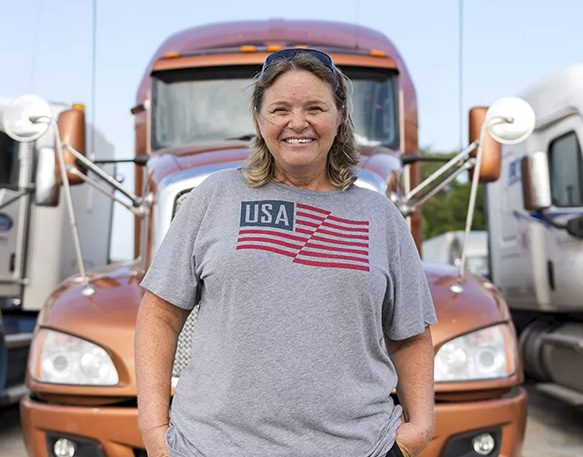As with anything, unlocking those benefits begins with getting a concrete understanding of what exactly we mean when we talk about intermodal trucking, what its advantages look like, and what tools will help you find the best opportunities in intermodal transportation. Read on to learn everything you need to know about intermodal trucking in this comprehensive guide.
What is intermodal trucking?
Practically every product you see is before you because of a complex logistics process involving the global supply chain. Whether its raw materials, component parts, or finished products, nearly all goods that need to travel will spend time in a trucking container that’s transported using sea, rail, road, or air transportation — often in combination. When that combined journey is used, it is called “intermodal freight transport.”
The broad intermodal definition refers to any two or more forms of transportation. However, intermodal trucking specifically is defined as a form of transportation where the first and last legs of the journey are executed by a truck while the middle portions occur over air, sea, or rail. This is different from over-the-road (OTR) trucking, where a single driver transports the freight for its entire journey from point A to point B, a process that often involves driving freight for days on end.
So how exactly does intermodal transportation differ from OTR?
In intermodal trucking, the distances that trucks transport goods are shorter than with OTR trucking (typically anywhere from 50 to 500 miles for intermodal trucking as opposed to hundreds or even thousands for OTR). Additionally, because the shipments are in containers, the truckers never touch the goods themselves, only ever handling the containers, and the goods never have to be repacked. Instead, the entire container is treated as a single unit of cargo that is sealed and secured throughout the entire transportation journey, except during Customs inspections.
How does intermodal trucking work?
Intermodal trucking fills in the gaps between other forms of transportation, namely sea, rail, and air transport. It is often necessary on both the front and back ends of freight journeys, getting products from their production points to railways or ports and then on to the distribution centers. Although trucks are also capable of transporting freight over long distances, they’re uniquely equipped to travel the short distances that sea, rail, and air transports cannot. With intermodal trucking involved in transportation, there are practically no destinations that are off-limits.
In terms of the practicalities, intermodal trucking is typically coordinated by a freight brokerage that manages multiple different parties, services, and pieces of equipment for moving cargo. The shipper then receives a single bill for all the coordinated services involved in the delivery of their freight.
Examples of intermodal trucking
There are a huge number of examples of intermodal trucking across different industries and verticals. For example, food distribution is an area that relies heavily on intermodal trucking. There, trucks carry the shipments from farms to rail or air transportation hubs. On the other end, different trucks carry the shipments from rail or air transportation hubs to a distribution center. From there, trucks will then carry the food to many different locations, for example the multiple different locations of a grocery store chain.
This same process is repeated daily on both a national and a global scale with everything from raw materials to clothing, farming products, industrial goods, florals, food, medicine, housewares, and much more. As long as a product can fit into a standard shipping container, it can be shipped via intermodal trucking. Intermodal transportation can even be used for goods that require temperature control with everything arriving in perfect condition despite moving between multiple transportation methods.
Benefits of intermodal trucking
Intermodal trucking offers many benefits for both shippers and carriers. For shippers, the benefits of intermodal trucking include:
- Flexibility: Because trucks can access practically any location by road and avoid the limitations of flight schedules, railway tracks, and ocean geographies, intermodal trucking offers more flexibility than simply relying on planes, trains, and ships to deliver cargo. Additionally, intermodal trucks can access pieces of public infrastructure that make it possible to deliver time-sensitive or perishable cargo effectively. This increased flexibility is a huge advantage to shippers across a wide variety of industries.
- Lower costs: Intermodal trucking offers significant cost savings compared to over-the-road (OTR) trucking. In both cases, each truck only transports a single shipping container at a time, however, since intermodal transportation means most of the cargo’s journey takes place on a a plane, train, or ship that can carry hundreds or thousands of shipping containers at the same time, transportation efficiency increases by a huge margin for the bulk of the journey. That transportation efficiency translates directly into cost efficiency.
- Less risk of damage: In intermodal trucking, once a shipping container is filled at its point of origin, it is never opened or left unattended until it reaches its final destination. Because there’s no need to re-pack cargo between transitions, the goods remain safely sealed throughout the entire journey, significantly reducing the risk of damage during transport.
With intermodal transportation, shippers aren’t the only ones who see clear advantages. Carriers who engage in intermodal trucking receive significant benefits as well. These include:
- Higher profit margins: Intermodal trips take less time than OTR and cover fewer miles. These shorter trips come with lower repair and fuel costs while pay remains approximately the same. That results in higher profit margins for carriers. Plus, intermodal trucking results in a reduced risk of theft or damage to goods inside the container since the containers are never opened or left unattended during the transportation process, meaning there is less chance of something going wrong that leads to added costs or insurance headaches.
- Shorter trips: With intermodal trucking, trips are regularly scheduled and are short compared to OTR trucking. This means that drivers don’t have to cook or sleep in their trucks and can have greater control over their schedules.
- Better balance: Shorter, more reliable trips go hand in hand with a better work-life balance for truckers, which often translates directly into a better quality of life. While there are certainly many drivers who are drawn to the diversity of experiences and long periods away from home presented by OTR trucking, there are others who prefer a more consistent schedule that keeps them close to home. In fact, it’s rare for intermodal truckers to spend more than one or two days away from home at a time. In short, with intermodal trucking, drivers spend fewer hours on the road, less time away from home, and more time with their friends and family. It’s the perfect option for drivers who seek predictability, routine, and more time at home as part of their work-life balance.
- Increased safety: Because cargo never leaves its trucking container once it’s packed and because those containers are loaded and unloaded between vehicles using special equipment, intermodal trucking offers extra safety benefits to drivers who don’t have to worry about handling any freight themselves. These safety advantages are particularly evident when it comes to transporting hazardous materials.
Additionally, intermodal trucking reduces highway congestion which increases safety in itself given that less cargo on the road means less chance of a trucker (or any other driver) getting into an accident.
And intermodal trucking offers one more major benefit to everyone, not just shippers and carriers: it’s eco-friendly. Using other modes of transportation instead of just trucks, especially over long distances, can significantly lower the carbon footprint of a freight journey. Reducing emissions is always a positive, but especially nowadays as both organizations and consumers look for more environmentally friendly ways to do business.
In short, intermodal transportation offers a broad range of benefits for carriers and shippers alike, making it a great option for businesses looking to cut costs and drivers looking to bring a bit more consistency into their work.
Unlock the benefits of intermodal trucking with DAT
It’s no surprise that intermodal trucking is becoming increasingly popular these days, with shippers warming up to the idea more and more due to insufficient rail capacity. Given its benefits for carriers and shippers alike and its environmental and safety advantages, intermodal trucking shows no signs of slowing down until rail capacity significantly increases. Plus, intermodal trucking offers fairly consistent work that makes discovering a healthy work-life balance easier for some carriers.
The best way to get into the intermodal trucking market is with the DAT load board, the largest load board in the freight industry. Whether you’re looking for OTR loads or intermodal opportunities, there’s always something new to discover on the DAT load board. With over 235 million loads posted every year and powerful search and posting capabilities, the DAT load board is the best place to get the most relevant matches for your business.
With DAT One mobile app, finding freight becomes even easier. The mobile app puts the full power of the DAT load board right in your pocket, with notifications whenever a new load matching your search criteria is posted. With DAT you can get the right load for the right truck at the right price, no matter where you are.
Sign up for the DAT load board to start finding great freight today!
Find the best freight with DAT!
The DAT load board is the largest freight marketplace in the industry, with thousands of new loads posted every single business day. It’s the best place to find the perfect freight for your business whether you’re looking for intermodal, OTR, or specialty freight. Sign up today to discover DAT for yourself!




